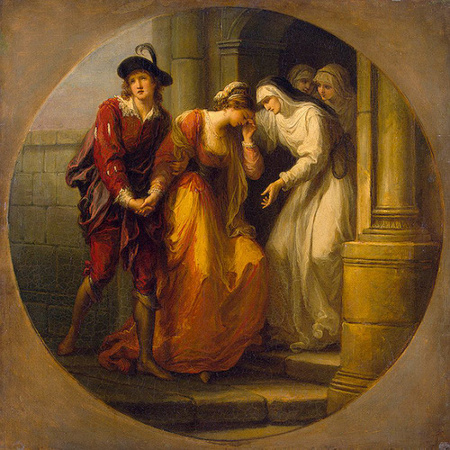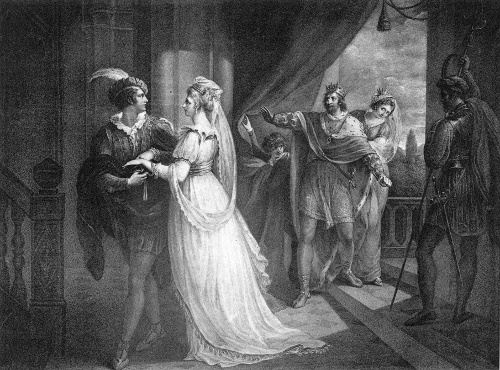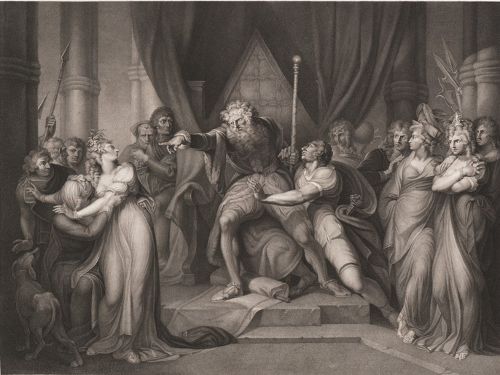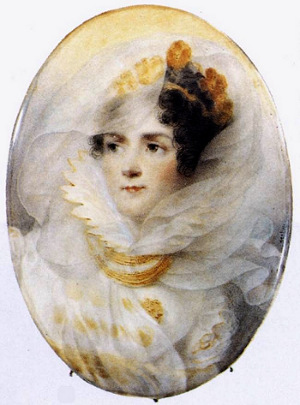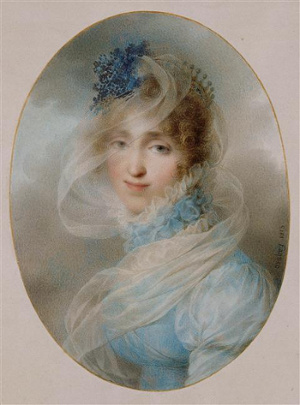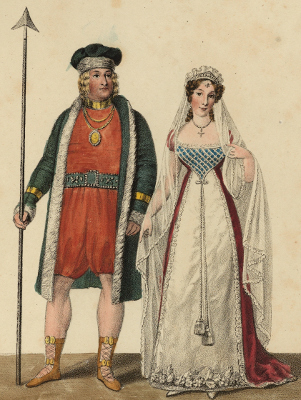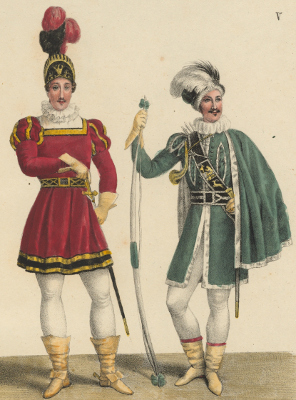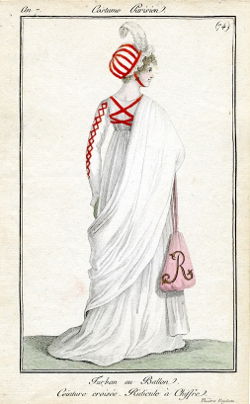|
In 1799, when the popularity of the Gothic novel was at its height, a “pantomime” entitled Feudal Times premiered at the Theatre Royal, Drury Lane. The play’s author, George Colman the Younger, like many others, was capitalizing on the vogue for medievalism with this elaborate spectacle, one of many Gothic-themed plays staged in London in the later eighteenth and early nineteenth centuries. However, a critic for The Gentleman’s Magazine, who signed his reviews “An Antiquary,” lamented the many historical inconsistencies in both the sets and the costumes. One character sported a Greek helmet, Caroline armor and a Jacobean ruff, while the soldiers under his command wore armor from the period of Edward III (r. 1312-1377); this eclecticism annoyed the critic, even though the time period of the play was apparently unspecified (Ranger 70-71).
Anyone today who likes to complain about slapdash inaccuracies of costuming in the film versions of Jane Austen’s novels may find some consolation in the knowledge that similar complaints were made about anachronisms in art and on the stage in the period of her lifetime. Although, as the comments of the “Antiquary” indicate, taste was gradually shifting toward greater historical accuracy in theatrical costume, a jumble of styles was still the rule until well into the nineteenth century.
Such a mishmash of period details in costuming was typical not only in the theater, where a certain practicality (picking out whatever was available in the costume shop) could be expected; depictions of the Middle Ages in the visual arts could be similarly eclectic. A painting of the Parting of Héloïse and Abelard by Angelica Kauffmann (c. 1780, State Hermitage Museum, St. Petersburg) puts its twelfth-century characters into a dashing but jumbled mixture of styles, mostly inspired by the Old Masters: a Rembrandtesque beret and Van Dyckian doublet and lace collar for Abelard, High Renaissance décolletage and Raphaelesque turban for Héloïse.
Aileen Ribeiro, describing the series of engravings illustrating great moments in the lives of English queens that Valentine Green executed (after various artists) between 1786 and 1792, states: “No matter if the scene was medieval or later, the costume shows the same mixture of Renaissance and Vandyke features for the men, and for the women it tends to be contemporary fashion with the addition of veils, ruffs, pearls and draperies” (Art of Dress 190). It would seem that Cassandra Austen’s portrait illustrations for her sister’s youthful History of England, with their mix of historical details and contemporary fashions, are no less sophisticated than the products of the most celebrated artists of her time.
Commentators of Austen’s day and since have generally disparaged this visual free-for-all. Sir Roy Strong, in his groundbreaking study of Romantic and Victorian painted recreations of British history, dismisses as “Gothick Picturesque” (somewhat condescendingly employing the eighteenth-century spelling of “gothic”) the attempts at visualizing the medieval and Tudor periods in the late eighteenth century, and criticizes artists for relying on visual effect at the expense of historical authenticity (49ff.). It was not until a few years after Austen’s death, when a combination of better access to archival materials, the popularity of the historical novels of Walter Scott and others, and the Victorian positivist approach to history would create a hunger for greater accuracy in art and on the stage.
Northanger Abbey itself has faced similar complaints. As Marilyn Butler puts it, many critics “suspect that the book does not hang together” (xv), that it is an uneasy combination of Burneyesque social commentary in Bath and burlesque of gothic novels at Northanger. However, as Butler argues, the novel is “a sophisticated performance” in its playful combination of genres: it “anticipates our own fin de siècle fascination with endlessly remaking what has been made before” (xvi). Butler also correctly notes that there is more overlap of genre in the novel than some critics have assumed (xxvi). It seems that this kind of “mélange” (to use Strong’s word for Gothick Picturesque dress) is almost endemic to the gothic genre, whether manifested in dress, in the fashionable novel, or in Austen’s parody.
Although the appeal of a “you are there” approach to historical recreation is understandable (however elusive it may be), I suggest that the mixture of dress styles of different periods suits the Gothic novel and has an aesthetic of its own. The eclecticism of Regency “Gothic” dress is analogous to the historical indeterminacy or “hybrid” nature of the fashionable Gothic novel, of which Ann Radcliffe’s Mysteries of Udolpho is a characteristic example. Just as the “gothic” was broadly defined at the time (anytime from the age of the Crusades to the early seventeenth century could fall under this rubric), so I define the “Regency” in its broadest terms (from the 1780s to the 1820s), as many historians have done before me. Since fashions and fashion plates still managed to go back and forth between Britain and the Continent in spite of war and blockade, both British and French examples are relevant. The Gothic aspects of Regency dress were made manifest in three significant ways: the revival, for both aesthetic and cultural reasons, of medieval and Renaissance dress elements in fashion; the uses of these elements in literature, both in Gothic novels and in Austen’s parody of them; and in the ghoulish and macabre elements of some of the fashions of Austen’s day. Austen’s awareness of the Gothic elements of contemporary fashion becomes apparent through the glimpses the reader gets of dress in Northanger Abbey.
Regency Gothic
The renewed interest in medieval and Renaissance dress was, of course, part of a larger Gothic Revival that began in the mid-eighteenth century. The gothic novels lampooned by Austen in Northanger Abbey were only one facet of this movement. Architects, visual artists and theatrical producers also increasingly turned to medieval styles and subjects as an alternative to the Greco-Roman tradition that had dominated Georgian taste. Medievalist nostalgia was closely tied to patriotism, especially for the British; Austen’s contemporaries saw the Middle Ages as the source of their political institutions (seen as under threat from revolutionary politics and social turmoil), and they celebrated the Elizabethan era as their national golden age.
In some ways, however, dress is different from the other visual arts. It is easier to accustom human beings to gazing at or wandering through architectural structures of an outmoded or “retro” style than it is to get them to wear outfits that they might consider outlandish, unflattering, or unglamorous. The clothes worn in art and on the stage tend to mirror what is worn in “real life,” whether consciously (because performers may wish to look stylish, and audiences prefer them to be so) or unconsciously (because artists, performers, and audiences alike are all so immersed in contemporary visual culture that many will not notice the inevitable anachronisms). On the other hand, stage costume can influence what people wear offstage, and aspects of current fashion might be introduced into works of art, making the interrelationship of art, theater, and fashion an extremely complex one.
Picturing the past
Throughout most of the eighteenth century, the visual sense of history was largely derived from the painters of the sixteenth and seventeenth centuries, whose work was, relatively speaking, readily available for inspiration. The influence of Rubens and the allure of the Caroline era fashions immortalized by Van Dyck—or “Vandyke,” as his name was usually spelled at the time—in both masquerade costume and portraiture in eighteenth-century Britain have been thoroughly documented by Aileen Ribeiro (Art of Dress 195ff.). Adapted seventeenth-century fashion elements can be seen in the glamorous full-length portraits of Gainsborough and the miniature portraits of Richard and Maria Cosway. The vogue for “Vandyke” dress was, to some extent, attributable to the enchantment-lending distance of the Civil Wars and (eventually) the Jacobite uprisings; but this vogue was also due to an admiration for the dashing elegance of the clothes themselves. The love for Caroline dress accounts for the curious use of “Vandyke” lace collars and slashed satin doublets to denote a medieval or Renaissance setting in art and in the theater. Similarly, as we shall see, ruffs and other elements of Renaissance dress became part of “gothic” costume in the early nineteenth century.
On a superficial level, the jumble of period styles in what I call Regency Gothic attire can be attributed to a lack of knowledge and of access to historical visual materials. It is true that that situation was starting to change: a number of scholars have documented the steady increase in books and manuals, published in both Britain and France, whose illustrations were intended to provide artists with historically correct visual models (Ribeiro, Art of Dress 171ff.; Mackrell, 45, 50). Even after these developments, however, the taste for a mixture of styles remained, largely, I believe because of their aesthetic and nostalgic appeal.
The mixture of period details in Regency Gothic dress is analogous to the mixtures of time periods to be found in gothic novels, which are unlike the historical novel of the type that were soon to be popularized by Sir Walter Scott. Scott’s novels are set in specific historical periods; however romanticized they may be, details of events, settings, and customs are carefully researched, with the desired effect of transporting the reader to a particular time and place. By contrast, the novels of Walpole, Radcliffe, and other gothic writers may specify a historical moment, but they are studded with anachronisms. The Mysteries of Udolpho refers to operas, coffee, and landaus, none of which were in existence (or, in the case of coffee, available in Europe) in the 1580s, when the novel is set. As Bonamy Dobrée puts it, “References to historical events in Mrs. Radcliffe’s novels . . . are sparse and frequently anachronistic because she was more interested in atmosphere than in authenticity”(673).
Gothic novels seem to be set in a kind of “Gothicworld” in which past and present are conflated in such a way as to make the world described both thrillingly immediate and romantically distant. Similarly, as Strong notes, Regency Gothic costumes are more about creating a striking visual effect than historical accuracy, an aim which I see as part of their charm. Far from being a failed attempt at authenticity, Regency Gothic dress has an aesthetic all its own, just as gothic novels constitute their own genre, and are not simply failed attempts at the historical novel.
The dress of characters in gothic novels is usually kept as vague as the historical details: Radcliffe can write lush and detailed descriptions of landscapes, but she will not say much more about clothing than an occasional reference to feathered hats, cloaks, or veils, all of which form a kind of shorthand for “olden time” costume. Northanger Abbey is, by contrast, so fashion-conscious that Austen felt the need to apologize for the novel’s dated quality in her Advertisement, written thirteen years after the book was (according to her) completed. Although the modish references of Austen’s novel seem to be in contrast to Radcliffe’s deliberate historic vagueness, Austen must have understood the gothic undertones in fashionable dress.
One of the earliest attempts to visualize a gothic novel (and the prototypical gothic novel at that) is John Carter’s Arrival of Frederick at the Castle of Otranto (1790, The Lewis Walpole Collection, Yale University Library). Carter was a serious antiquarian, who took considerable care with architectural details, but he is somewhat more vague with the costumes. Strong notes that “[the] general feel is that of the late fifteenth century” (66), although elements of sixteenth-century armor also appear, and the women’s dresses flair out in a way that looks more like the fashions of c. 1790. In any case, Walpole dates the story to sometime between 1095 and 1243, the age of the Crusades, so from a purist standpoint, the setting and costumes are anachronistic; it is a visualization of “Gothicworld.” Similarly, Lady Diana Beauclerk’s illustrations to Walpole’s sensationalistic (and generally considered to be unstageable) play The Mysterious Mother (1775-76, The Lewis Walpole Collection, Yale University Library) put its characters into an approximation of mid-sixteenth-century dress; in this instance, the time period of the play is not specified.
With the exception of the posthumously published Gaston de Blondeville, which takes place during the thirteenth century, most of Radcliffe’s novels are not set in the “Gothic” Middle Ages, that is, when an historical period is specified. A Sicilian Romance and The Mysteries of Udolpho are set in the late sixteenth century, and the plot of The Italian transpires in 1764, not even half a century before the novel was written. On one level, the post-medieval settings of gothic novels make sense: those historical periods when gothic edifices were already in a state of dilapidation would make for a more romantically evocative setting than the periods when such structures would be newly built. “Gothic,” whether in the crumbling creepiness of Udolpho or the faded splendors of Chateau-le-Blanc, is already a thing of the past for Radcliffe’s characters, multiplying the effect of distance from the modern reader.
The fact that one can speak of the “fashionable gothic” novel implies the same collapsing of past and present, the combination of the modish and the bizarre that characterize Regency Gothic dress. Austen must have understood this historical layering, and it becomes part of her satire of the gothic genre. As Catherine discovers to her disappointment, Northanger Abbey itself is gothic in name only, a modern building with all the modern conveniences.
Nationalist nostalgia
A desire to turn to the Middle Ages and the Renaissance as an alternative to the Greco-Roman tradition was not unique to Britain. Concurrent with the British taste for “Vandyke” dress, nostalgia for the reign of Henri IV (1589-1610) was developing in France. Henri IV was seen as a peacemaker, a bon vivant, an open-minded thinker, and a populist, and his “cult” was confirmed by Voltaire’s epic poem L’Henriade (1723). This “cult” was given more popular form in Charles Collé’s 1774 play, La Partie de chasse de Henri IV [The Hunting Party of Henri IV], in which, among other magnanimous acts, the good-natured monarch rescues an innocent peasant girl from the clutches of one of his corrupt courtiers.
In the late eighteenth century, it was viewed as a happy coincidence that the reigns of Henri IV and Elizabeth I (r. 1558-1603) overlapped, thus bringing together two Golden Ages, and ensuring the allure of the dress of circa 1600 on both sides of the Channel. Nostalgia for the Elizabethan era intensified in Britain even before the surge in patriotism, in a reaction to the French Revolution and the war with France from the 1790s onward. It reached a kind of zenith in the extravagant coronation of the dedicatee of Emma as King George IV in 1821, at which the architectural decorations may have been gothic, but the specially designed costumes were primarily inspired by both Elizabethan models and the age of Henri IV, whom George also revered.
The cult of Elizabeth went hand-in-hand with the growing cult of Shakespeare, the towering genius of that Golden Age, and of English literature in general. Among other products, this reverence inspired that artistic-cum-commercial-cum-patriotic project, the Boydell Shakespeare Gallery. Spearheaded by publisher Alderman John Boydell, the Shakespeare Gallery was to have three components: a gallery of works of art depicting scenes from Shakespeare, which opened on Pall Mall in 1789 and ultimately included about 170 paintings (and two sculptures) by thirty-three different artists; a set of engravings from those paintings, which could be sold by subscription to discerning collectors; and a lavish edition of Shakespeare’s work using the prints as illustrations. Although ultimately a financial failure, Boydell’s project is an important moment in the “rediscovery” of Shakespeare.
Much scholarship has been devoted to various aspects of the Shakespeare Gallery, but more work needs to be done on the costuming employed in the imagery. To what extent do the costumes reflect the realities of the contemporary stage? Even at the time, commentators were divided as to whether the artist-illustrators should take inspiration from the best of current performance practice or should avoid “the meretricious foppery of the modern stage” altogether.1 Any possibility that the Boydell Shakespeare illustrations might have influenced actual stage practice is also questionable. Although the gallery of paintings was well attended, Stuart Sillars points out that virtually no one on the list of subscribers to the printed edition (or, at least, on the one such list that has survived) is associated with the professional theater (258).
In the Boydell Shakespeare, a wide diversity of dress styles is discernable, often in the same image. John Opie puts the Countess of Auvergne (Henry VI, Part I) into a costume similar to that worn by Sarah Siddons in Arthur Murphy’s play The Grecian Daughter—Roman diadem, wide sash, and looped and fringed overskirt—while the soldiers wear a mixture of fifteenth and sixteenth century armor. In William Hamilton’s illustration for Cymbeline, the king wears a medieval tunic, Posthumus sports a slimmed-down Elizabethan doublet and trunk hose (with matching slashed and feathered cap), and Imogen’s gown largely follows the fashion of the 1790s, but with scalloped edges (thought to be a distinctly medieval feature) on her veil and train. The combination of elements lends a fairytale quality that suits the atmosphere of late Shakespearean romance.
Surely the most imaginative of Boydell’s artists is Henry Fuseli, already notorious for the disturbing and erotic qualities of his imagery. Fuseli’s illustrations combine impossibly tight and flexible armor that emphasizes the muscular physiques of male characters,2 mixed with entirely re-imagined elements of Elizabethan dress and contemporary fashion. King Lear Repudiating his Daughter Cordelia has the men in radically simplified Tudor doublets and peculiar hose that makes them look like écorchés (drawings of flayed human figures used as an artistic exercise), while the women wear particularly clingy versions of fashionable dress, their 1790s coiffures topped with eccentric headdresses that probably come from the artist’s imagination. A scene of intense psychological tension receives from the costumes an extra dose of eroticism that would have been unthinkable on the contemporary stage.
Still, the mixture of costume elements does indeed reflect the eclecticism of contemporary stage productions. Although stage costume typically incorporates current fashions, it had long been customary for certain characters (for example, Falstaff, Richard III, Henry VIII) to be dressed in “historic costume,” although the phrase can be employed somewhat broadly—“Vandyke” costume for the supposedly fifteenth century Falstaff, for example. David Garrick’s costume as Richard III (immortalized by Hogarth) displays a mixture of early Tudor tunic and Elizabethan ruff that became standard for the character, as can be seen in representations of Edmund Kean, the idol of Austen’s heyday, in the same role almost seventy years later.3
Ruffs, puffs and slashes
There were certain fashion elements that particularly evoked the past for Regency viewers, and these elements could be employed even to illustrate periods in which these elements did not exist. Ruffs, for example, began in the early sixteenth century as ruffles around the neck, but, thanks to starch and wire, they became increasingly elaborate structures until they went out of style in the mid-seventeenth century. Their return to fashion began with the masquerade costumes of the eighteenth century.
The definitive return of ruffs (called interchangeably collerettes, fraises or chérusques) can be attributed to Empress Josephine (Mackrell 59-60). At her husband’s coronation as Emperor of the French in 1804, Josephine’s costume combined a luxurious satin version of the fashionable high-waisted dress with classically inspired jewelry, a spiky lace collar derived from the portraits of Marie de’ Medici, consort of Henri IV, and long sleeves that, as Ribeiro has noted, are similar to those seen in portraits by fifteenth century artists like van der Goes and Memling (Art of Dress. 160). Some of these elements made their way into contemporary fashion, combining with the prevailing neoclassical styles to create a mélange similar to other manifestations of Regency Gothic.
Josephine also popularized both the smaller, neck-encircling sixteenth-century style ruffs and the multilayered spiky ruffs of the mid-seventeenth, such as the one she wears in a miniature by Isabey in the Wallace Collection. Jean-Baptiste Isabey, who had designed the official costumes for Napoleon’s court, painted Josephine’s daughter, Queen Hortense, in an elegantly small, sixteenth-century style ruff (1813, Malmaison). After the Restoration, this smaller ruff took over completely; the collerette à la Médicis, despite its origins in the age of Henri IV, was no doubt too much associated with the Napoleonic regime to survive.
Josephine’s archaizing tastes made other Renaissance-style elements fashionable as well. These included puffed sleeves at the shoulders, usually slashed (a sixteenth century style that supposedly originated with swaggering soldiers who wore the stolen clothes of their slain victims, slashed to show contempt), and smaller puffed, slashed, and plumed toques or berets, in the manner of another popular French king, François I (r. 1515-1547). Most of these elements would continue in fashion, becoming larger and more exaggerated beginning in the mid-1820s and reaching the heights (or depths, according to taste) of extravagance during the 1830s.
Men might wear the revived ruffs of the early nineteenth century as part of official costume, particularly at the courts of Napoleon and the various satellite states set up by his regime. Regency men did not wear ruffs for fashionable purposes, although the high collars and complex cravats worn from the 1790s onward can produce rather similar effects. Nor did men wear the same puffed and slashed sleeves that women wore, but the shoulders of their frock coats do puff up a bit, again producing a similar effect to the puffed sleeves of women’s garments.
Capes, cloaks and greatcoats
These subtle similarities between male and female attire, however, should not obscure the fact that this period saw the initial development of what would become the modern male suit. Austen’s lifetime was a period in which questions about and definitions of masculinity were of paramount importance (see Myrone). Both Radcliffe’s and Austen’s novels are a part of this discussion: who is more “manly,” the gallant Valancourt, or the ruthless Montoni? the witty, gentleman-like Henry Tilney, or his cynical, womanizing brother? Similar questions could be posed in regard to Regency male dress. What makes a man look more masculine, the red coat and glittering decorations of military uniform, or the crisply tailored understatement of a Beau Brummell?
In gothic novels, machismo is enhanced by the wearing of other “olden time” elements, the cape and the cloak. In Udolpho, some of Montoni’s mounted henchmen wear, along with their “small Italian caps” decorated with black feathers, “a cloak, of plain black, which, covering the person entirely, hung down to the stirrups” (302). Connoisseurs among Radcliffe’s readership would have recognized that such attire derives ultimately from the ragtag soldiers and “banditti” who lurk in the wild landscapes depicted by the seventeenth-century Neapolitan painter Salvator Rosa, whom she evokes earlier in the novel (30).
Short capes were one of the retro-Renaissance elements incorporated into Napoleonic court costume, and the fur-lined jackets slung jauntily over one shoulder in military garb produced a similar effect. Toward 1820, longer evening cloaks became fashionable for men, enveloping them (in every sense) within an aura of sinister elegance that still lingers (cf. Dracula, or the Phantom of the Opera). Of course, this was a period in which outerwear became increasingly important for women as well as men, as the cloaks, spencers, and pelisses of feminine fashion indicate; but, in terms of “gothic” glamour, the men of the 1790s and early 1800s had the advantage of the greatcoat.
Greatcoats (or great coats) were a striking combination of cloak and cape. They were particularly associated with carriage driving, where their large collars—called, in fact, “capes” (Byrde 93)—could flap dramatically while in motion. The anonymity provided by the greatcoat must have been unsettling for a class-conscious society: it would have been difficult to distinguish between a hired coachman and a “gentleman” driver. One need look no further than the references to the greatcoat in Northanger Abbey to understand its enhancement of male sexual allure, whether dashing (“And then his hat sat so well, and the innumerable capes of his great coat looked so becomingly important!” [157]) or dangerous (“He cannot be the instigator of the three villains in horsemen's great coats, by whom she will hereafter be forced into a travelling-chaise and four, which will drive off with incredible speed” [131]). The coat apparently had an air of gothic grand seigneur about it: General Tilney uses his greatcoat selfishly to take up space in a curricle (155). All of these sexy and sinister connotations of the greatcoat may explain why the bluffly kindhearted Mr. Allen refuses to “‘walk out’” in one, however practical it may be (83).
The vaguely sixteenth century combination of collar and cape or cloak became part of masculine Regency Gothic dress on the stage as well. John Philip Kemble’s 1805 costume as Hamlet was a “pseudo-Elizabethan costume (except for the Van Dyck falling collar) with puffed sleeves and trunk hose” (Laver 101). When the time period of a play was not specified, the preference, almost the default choice, seems to have been for sixteenth-century costuming: the 1800 staging of Joanna Baillie’s De Monfort at Drury Lane featured spectacular sets by William Capon in fourteenth-century style, but prints show the title character (perhaps inspired by Kemble or Kean) in Elizabethan ruff and trunk hose.4
It is clear that, quite apart from their historical associations, all of these elements of dress were popular for aesthetic reasons. As the sixteenth century recognized, ruffs frame the face quite becomingly, and they can lend a graceful or “proud” tilt to the neck. Puffed sleeves can give the illusion of a narrower waist (or wherever the beltline may be), and they flatter figures of all shapes and sizes in a way that the ultra-short sleeves of circa 1800 did not. Feathered hats, particularly if cocked to one side, can make even the most unassuming person look dashing. The same could be said of capes and cloaks. Slashing of fabrics allows for the luxurious display of multiple layers; velvet sleeves, slashed to reveal satin underneath and connected by jeweled clasps, are the ultimate in conspicuous display.
Thus, it is not surprising that sixteenth century styles remained attractive, even after knowledge of medieval dress increased and the novels of Walter Scott made the specificities of different historical periods more accessible. At a masquerade ball given in Brussels in February 1823, a group of British guests appeared as characters from Scott’s Ivanhoe. The plumed helmets worn by the knightly characters look medieval enough (although of the fifteenth century, rather than the twelfth century in which the novel is set), but the costumes of men and women alike feature the Renaissance ruffs and puffs that were still too irresistible to abandon (see Lagarenne, plates I-X).
Veils
Illustrations of the participants in that 1823 “Ivanhoe Quadrille” reveal one more fashion feature that had acquired strong “gothic” associations: the women wear long, gauzy veils. After almost 150 years of relative neglect, veils reappeared in the 1790s. They were originally part of the neoclassical aesthetic, given their similarity to Greco-Roman drapery, but they became particularly associated with the Gothic Revival.
Veils are, in some ways, the quintessential “gothic” accessory: draped head coverings were worn during the Middle Ages, particularly by married women and, of course, nuns. Also, they flow and flutter so poetically, like heraldic banners. On a more metaphorical level, veils are essential for the interplay of concealing and revealing that are essential components of the gothic novel. Whatever atrocities may transpire, Emily, the heroine of Udolpho, usually has the presence of mind to wear a veil, and she has the crumbling black veil of a deceased character thrown over her at a particularly creepy moment in the novel. Furthermore, veils share common elements with the tapestries and curtains of the novels: the aura of mystery and suspense, the moments of sudden revelation. Austen’s narrator neatly links the simultaneously mysterious and revelatory nature of veils and novels: “Would the veil in which Mrs. Tilney had last walked, or the volume in which she had last read, remain to tell what nothing else was allowed to whisper?” (194). Of course, in gothic novels the pulling back of curtains (like the “black veil” in Udolpho that so fascinates Catherine Morland and Isabella Thorpe [NA 39-40]) invariably uncovers something “horrid,” while in the fashionable world veils were closely related to traits that were considered stereotypically “feminine”: modesty and glamor.
Unlike ruffs and puffs, veils were the exclusive preserve of women. Once again, Empress Josephine, Queen Hortense, and Jean-Baptiste Isabey were the influential trio who helped to popularize this romantic accessory, which could be made of lace, silk, or muslin (Mackrell 64). The most characteristic images of Isabey’s artistic output are the portrait miniatures he executed of famous and fashionable women; veils swirl like clouds around the sitters, half-concealing and half-revealing their sweetly smiling faces.
The association of veils both with medieval revival and “feminine mystique” reached a kind of apotheosis at the Congress of Vienna in 1814. One of the great events of the Congress was the spectacular Carrousel, an early attempt to recreate a medieval tournament, which took place in the Spanish Riding School. There were twenty-four “Queens of Love” presiding, chosen from among the “leading ladies” of the Congress, including the Duchess of Sagan and her sister, later the Duchesse de Dino. The Queens of Love wore rich velvet and satin gowns, with the expected ruffs, puffs, and slashes, decorated with all the jewels they owned (or could borrow). They entered the arena with faces veiled and were escorted to their seats by the dashing young men who would be participating as knights (themselves garbed in early sixteenth-century style doublets, breastplates, and plumed hats). Heralds sounded fanfares, and the “Queens of Love” threw back their veils all at once, to rapturous applause from the spectators.5
Regency Goths
Finally, I would like to mention some elements of the fashions of Austen’s lifetime that could be described as “gothic” not in terms of historical revival, but in terms of their ghoulish or macabre qualities. Such “gothic” elements can be identified in two broad categories: the impact of the French Revolution, and the wearing of black.
It is not surprising that gothic novels should have been so popular in the 1790s, a decade that included the Terrorist phase of the French Revolution, and British anxieties about both the spread of Revolutionary ideas and the possibility of a French invasion. In the immediate aftermath of the Terror, some women in France began to cut their hair short and to wear crisscrossed red bands on their backs; both elements were derived from the ways in which people were prepared to be guillotined, and these styles were referred to as “à la victime.”6 Wigs became fashionable again in Paris in the late 1790s as well. Some women (like the stylish and daring Thérèse Tallien) liked to explore multiple looks and identities by wearing wigs of different colors. According to current gossip, the hair for these wigs came from victims of the Terror, lending a further ghoulish quality to current fashion (Lajer-Burcharth 191-93).
An even more disturbing accessory was a red ribbon worn around the neck, in imitation of the cut of the guillotine blade. These ribbons apparently also made their way across the Channel: the bizarrely elegant daughter of John Milton wears one in Fuseli’s dreamlike representation of Blind Milton Dictating to his Daughter (1794, Art Institute of Chicago). Originally, these macabre fashion elements were supposed to be worn only by women who had lost family members to the guillotine, but no doubt others adopted them simply because of their modishness.
Today, if anyone were to refer to “Goth” dress, one of the first images (or stereotypes) to come to mind would probably be the wearing of black. Black as a color in dress has a long and complex history, but there is no question that the broadly-defined Regency era was a major moment in that historical trajectory.
Black suits for men originated in the 1780s as part of the vogue for Rousseauean “natural simplicity.” Because black was seen as the polar opposite of colorful, self-indulgent (read “aristocratic”) extravagance, it became a popular color for clothing with some republican leaders during the French Revolution. Thus, for the British, black suits may have had slightly dangerous Jacobin connotations. At the same time, there was a long history of associating black with melancholy, a condition to which the British considered themselves particularly susceptible. This combination assured the association of the wearing of black with a kind of sinister elegance. Once again, we can look to aesthetics: black, like puffed shoulders, is supposed to be “slimming,” and it can emphasize ghostly pallor. A man in black must have made quite an effect at the time, surrounded by the blues, bottle greens, buffs, and fawns that were still the mainstays of male attire. Certainly, such a look would have made a stark contrast to the prevalence in women’s fashions of white, the hallmark of elegance in the wardrobe of Eleanor Tilney.
The “gothic” associations of black became fixed at this period, and have never entirely disappeared. As Anne Hollander states, “[Black] is the proper dress of the magician, of Dracula—even in the morning. . . . Wicked doings were thought of, since Romantic times, as conventionally carried on by black-clad men—originally, perverted priests and monks in cassocks and cowls; later, depraved youths in evening dress; and, finally, bloated capitalists and sneaky politicians in cutaways and top hats” (376). In one sentence, Hollander brilliantly draws a line from “Monk” Lewis to Byron to the Robber Barons, gothic characters all.
There is something almost postmodern about Regency Gothic dress, with its playful picking and choosing of historic elements, its collapsing of past and present, its visual mélange. Today’s creators of Austen-based “mashups” involving various monsters and vampires are playing a similar game, as indeed was Austen herself in writing that mashup of social novel and gothic spoof that we call Northanger Abbey. Perhaps that is why, if we open our eyes and minds to it, Regency Gothic dress is a style that we can still find (pardon the pun) haunting today. Notes 1. From an unsigned letter to The Gentleman’s Magazine, Vol. LVIII, part II, no. 3, September 1788 (qtd. in Sillars 261).
2. Myrone comments on the almost absurdly excessive masculinity of Fuseli’s male figures.
3. See Ribeiro, Art of Dress 188; Desmond Shawe-Taylor, in Martineau 130.
4. See Ranger (61-62, 101). Like Radcliffe’s characters, De Monfort also enjoys his cup of coffee.
5. See King (153-54). Incidentally, many of these women had been painted by Isabey (still popular despite his Napoleonic connections), who, like “all Europe” was in Vienna at the time.
6. See Ribeiro, Fashion in the French Revolution (122-24) and Lajer-Burcharth (193). Works Cited Austen, Jane. The Novels of Jane Austen. Ed. R. W. Chapman. 3rd ed. Oxford: OUP, 1933-69. Austen, Jane. Northanger Abbey. Ed. R. W. Chapman. 3rd ed. Oxford: Oxford UP, 1933. Butler, Marilyn. “Introduction.” Northanger Abbey. London: Penguin, 1996. xi-xlviii. Byrde, Penelope. Jane Austen Fashion: Fashion and Needlework in the Works of Jane Austen. London: Excellent P, 1999. Hollander, Anne. Seeing Through Clothes. New York: Viking, 1975. King, David. Vienna 1814: How the Conquerors of Napoleon Made Love, War, and Peace at the Congress of Vienna. New York: Random, 2008. Lagarenne, Félicité. Costumes d’Ivanhoe au bal donné par LL. AA. R. et I. le prince et la princesse d’Orange à Bruxelles, mercredi le 5 février 1823. Brussels (?), 1823(?). Lajer-Burcharth, Ewa. Necklines: The Art of Jacques-Louis David After the Terror. New Haven: Yale UP, 1999. Laver, James. Costume in the Theatre. London: Harrap, 1964. Martineau, Jane, ed. Shakespeare in Art. London: Merrell, 2003. Mackrell, Alice. Art and Fashion: The Impact of Art on Fashion and Fashion on Art. London: Batsford, 2005. Myrone, Martin. “Gothic Romance and the Quixotic Hero: A Pageant for Henry Fuseli in 1783.” Tate Papers 1 (Spr. 2004). http://www.tate.org.uk/research/tateresearch/tatepapers/04spring/gothic_paper.htm Radcliffe, Ann. The Mysteries of Udolpho. Ed. Bonamy Dobrée. Oxford: Oxford UP, 1966. Ranger, Paul. ‘Terror and Pity reign in every Breast’: Gothic Drama in the London Patent Theatres, 1750-1820. London: Society for Theatre Research, 1991. Ribeiro, Aileen. The Art of Dress: Fashion in England and France 1750 to 1820. New Haven: Yale UP, 1995. _____. Fashion in the French Revolution. New York: Holmes & Meier, 1988. Sillars, Stuart. Painting Shakespeare: The Artist as Critic 1720-1820. Cambridge: Cambridge UP, 2006. Strong, Roy. And When Did You Last See Your Father: The Victorian Painter and British History. London: Thames & Hudson, 1978. Pub. in the U.S. as Recreating the Past: British History and the Victorian Painter. New York: Norton, 1978.
|


